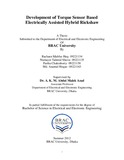| dc.contributor.advisor | Azad, A. K. M. Abdul Malek | |
| dc.contributor.author | Huq, Rachaen Mahfuz | |
| dc.contributor.author | Shuvo, Numayer Tahmid | |
| dc.contributor.author | Chakraborty, Partha | |
| dc.contributor.author | Hoque, Md. Anamul | |
| dc.date.accessioned | 2013-03-20T11:02:49Z | |
| dc.date.available | 2013-03-20T11:02:49Z | |
| dc.date.copyright | 2012 | |
| dc.date.issued | 2012-09-04 | |
| dc.identifier.other | ID 09221134 | |
| dc.identifier.other | ID 09221135 | |
| dc.identifier.other | ID 09221150 | |
| dc.identifier.other | ID 09221163 | |
| dc.identifier.uri | http://hdl.handle.net/10361/2122 | |
| dc.description | This thesis report is submitted in partial fulfillment of the requirements for the degree of Bachelor of Science in Electrical and Electronic Engineering, 2012. | |
| dc.description | Cataloged from PDF version of thesis report. | |
| dc.description | Includes bibliographical references (page 60-61). | |
| dc.description.abstract | Cycle rickshaws are the most popular form of transportation inside the cities of
Bangladesh, especially for its route and time-flexibility and door-to-door services.
Considering the fact that a significant portion of underprivileged population of
Bangladesh is directly or indirectly dependent upon the rickshaw-pulling profession, the
necessity of scientifically thinking about its improvement and modernization was
apparent. This paper describes a research and development project of Control and
Applications Research Group, BRAC University, aiming to modernize these green fuelfree
transports of Bangladesh using power-assistive technology. This involves design and
implementation of an intelligent control system that would make the rickshaw pulling
task easier-to-feel by assisting the human power with a motor, turning it into a hybrid
vehicle. The motivation of the project was to relieve the rickshaw pullers from the
excessive physical exhaustion associated with the task, which mainly occurs while
initiating the momentum from rest or low speed to a moderate speed. A motor helping the
pullers only during this particular time eradicates this exhaustion to a significant extent,
at the same time saves energy by limiting over-use of the motor. A torque-sensor was
involved to determine the need-of-assistance a puller feels at a particular time, and an
external controller in addition to the motor controller was designed and tested. The model
was developed so as to save energy, limit overuse, and keeping the identity and driving
mechanism of old rickshaws. An idea of battery charging infrastructure using Solar-
Battery-Charging-Station is also mentioned as a core factor of the project. | en_US |
| dc.description.statementofresponsibility | Rachaen Mahfuz Huq | |
| dc.description.statementofresponsibility | Numayer Tahmid Shuvo | |
| dc.description.statementofresponsibility | Partha Chakraborty | |
| dc.description.statementofresponsibility | Md. Anamul Hoque | |
| dc.format.extent | 100 pages | |
| dc.publisher | Department of Electrical and Electronic Engineering (EEE) | en_US |
| dc.rights | BRAC University thesis are protected by copyright. They may be viewed from this source for any purpose, but reproduction or distribution in any format is prohibited without written permission. | |
| dc.subject | Electrical and electronic engineering | |
| dc.title | Development of Torque Sensor Based Electrically Assisted Hybrid Rickshaw | en_US |
| dc.type | Thesis | en_US |
| dc.contributor.department | Department of Electrical and Electronic Engineering, BRAC University | |
| dc.description.degree | B. Electrical and Electronic Engineering | |

